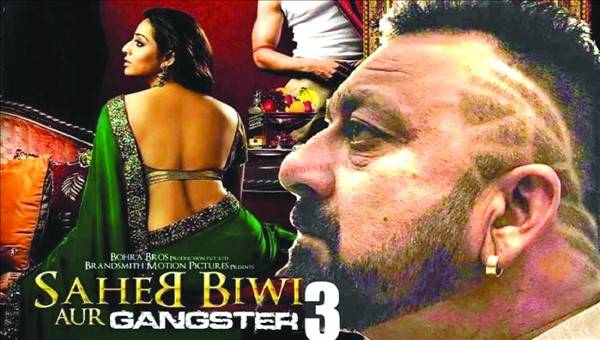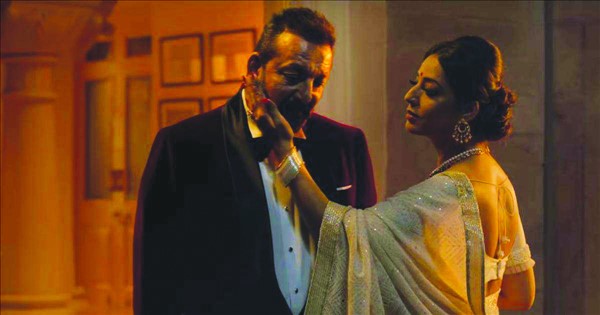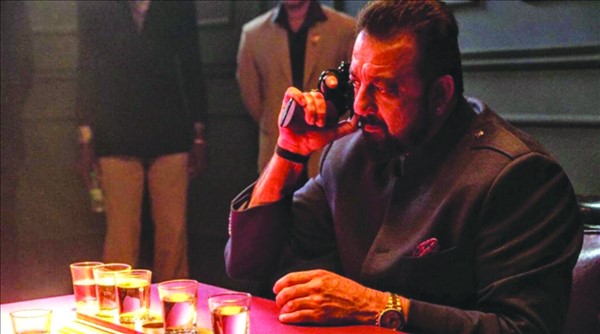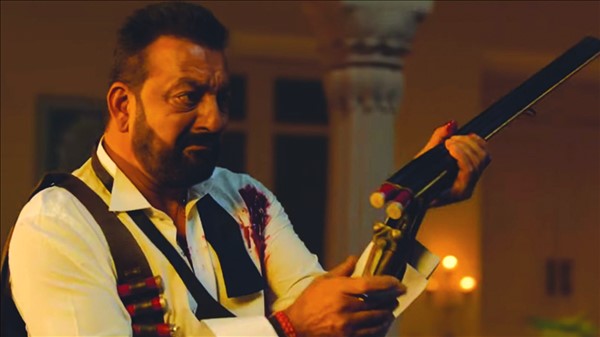
With the recently concluded election season, coupled with the most followed Bollywood movie in recent memory Sanju, a political thriller starring Sanjay Dutt would be a shoo-in for success in our neck of the woods. Except that it wasn’t.
The third installment of Saheb, Biwi aur Gangster, which took five years in the making – around the same time it took for the new government to form in Pakistan – has finally given the franchise a glaring failure.
While the first two movies were resounding all-round wins in terms of Box Office numbers, critical acclaim and a cult following, Saheb, Biwi aur Gangster 3 could be strike three for the series, and maybe compel it to call it a day.
The primary reason behind this verdict is that in half a decade, the franchise had nothing new to offer the audience, who would have realised that a rerun of either of the first two films would have made for a better third part.

Continuing from where they have been throughout this decade, Aditya Pratap Singh (Jimmy Shergill) and his wife Madhavi (Mahie Gill) continue to indulge in the games that years ago were fresh and intriguing, and which now are repetitive and redundant.
Jailed in Saheb, Biwi Aur Gangster Returns, Aditya returns in the third installment, vying to reclaim his politics. That bid runs up against a Rajasthani prince Uday Pratap Singh (Sanjay Dutt), triggering a series of incidents, the whole purpose of which is to create a web without necessarily converging on a point exciting enough to make it all worth the hassle.

Father Maharaja Hari Singh (Kabir Bedi) and brother Vijay (Deepak Tijori) aren’t pleased that Uday has had to return from London, after being deported. You can see a property dispute heading your way from five kilometres outside the multiplex.
Then there is Suhani (Chitrangda Singh), a courtesan who provides more angles to the conspiracies already engulfing Uday Pratap.
Those who have seen the first two parts of the franchise would realise that the similarities are glaring in terms of the film’s aura and composition. The primary issue is that not only does the third part take the commonalities to a point where the fans of the franchise would struggle to find anything new, even the repetition isn’t carried out with sufficient sincerity for the film to pass as another similarly shaped leaf out of the film’s royal chest.

That all of this takes place in the presence of Jimmy Shergill and Sanjay Dutt is particularly damaging. While the former manages to reprise what he has done in the previous two installments – even if it took as long as the second half for him to get going – the latter’s addition has proved damaging for both the franchise and his own stalled bid for a comeback.
Arguably, what is an even bigger shock is the writing in Saheb, Biwi aur Gangster 3 which pales in front of the first two movies. The film retains its royal core, but in the third movie it has become a backdrop to put together a string of crazed up characters, not really playing out the mould that has been set for them.
Tigmanshu Dhulia falls short. He is clearly relying on the acting talent in the frame to salvage the scenes, and in turn the overall production. The addition of Sanjay Dutt has meant the focus being on the actor more than the film and screenplay, with Dutt not being able to carry a role for which, if truth be told, he wouldn’t have been a seamless fit even in his heyday.
If you’re a Saheb, Biwi aur Gangster loyalist, the film might be worth a single watch. Even that should be done keeping in mind the inevitable disappointment that would be in story. Those who haven’t seen its predecessors should definitely steer clear of Saheb, Biwi aur Gangster 3.
The third installment of Saheb, Biwi aur Gangster, which took five years in the making – around the same time it took for the new government to form in Pakistan – has finally given the franchise a glaring failure.
While the first two movies were resounding all-round wins in terms of Box Office numbers, critical acclaim and a cult following, Saheb, Biwi aur Gangster 3 could be strike three for the series, and maybe compel it to call it a day.
The primary reason behind this verdict is that in half a decade, the franchise had nothing new to offer the audience, who would have realised that a rerun of either of the first two films would have made for a better third part.

That all of this takes place in the presence of Jimmy Shergill and Sanjay Dutt is particularly damaging
Continuing from where they have been throughout this decade, Aditya Pratap Singh (Jimmy Shergill) and his wife Madhavi (Mahie Gill) continue to indulge in the games that years ago were fresh and intriguing, and which now are repetitive and redundant.
Jailed in Saheb, Biwi Aur Gangster Returns, Aditya returns in the third installment, vying to reclaim his politics. That bid runs up against a Rajasthani prince Uday Pratap Singh (Sanjay Dutt), triggering a series of incidents, the whole purpose of which is to create a web without necessarily converging on a point exciting enough to make it all worth the hassle.

Father Maharaja Hari Singh (Kabir Bedi) and brother Vijay (Deepak Tijori) aren’t pleased that Uday has had to return from London, after being deported. You can see a property dispute heading your way from five kilometres outside the multiplex.
Then there is Suhani (Chitrangda Singh), a courtesan who provides more angles to the conspiracies already engulfing Uday Pratap.
Those who have seen the first two parts of the franchise would realise that the similarities are glaring in terms of the film’s aura and composition. The primary issue is that not only does the third part take the commonalities to a point where the fans of the franchise would struggle to find anything new, even the repetition isn’t carried out with sufficient sincerity for the film to pass as another similarly shaped leaf out of the film’s royal chest.

That all of this takes place in the presence of Jimmy Shergill and Sanjay Dutt is particularly damaging. While the former manages to reprise what he has done in the previous two installments – even if it took as long as the second half for him to get going – the latter’s addition has proved damaging for both the franchise and his own stalled bid for a comeback.
Arguably, what is an even bigger shock is the writing in Saheb, Biwi aur Gangster 3 which pales in front of the first two movies. The film retains its royal core, but in the third movie it has become a backdrop to put together a string of crazed up characters, not really playing out the mould that has been set for them.
Tigmanshu Dhulia falls short. He is clearly relying on the acting talent in the frame to salvage the scenes, and in turn the overall production. The addition of Sanjay Dutt has meant the focus being on the actor more than the film and screenplay, with Dutt not being able to carry a role for which, if truth be told, he wouldn’t have been a seamless fit even in his heyday.
If you’re a Saheb, Biwi aur Gangster loyalist, the film might be worth a single watch. Even that should be done keeping in mind the inevitable disappointment that would be in story. Those who haven’t seen its predecessors should definitely steer clear of Saheb, Biwi aur Gangster 3.

